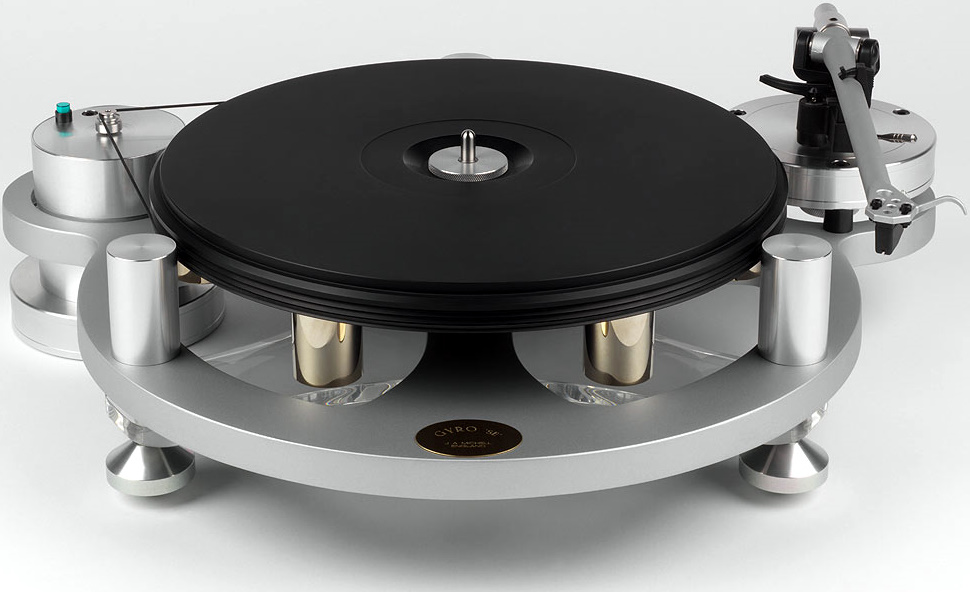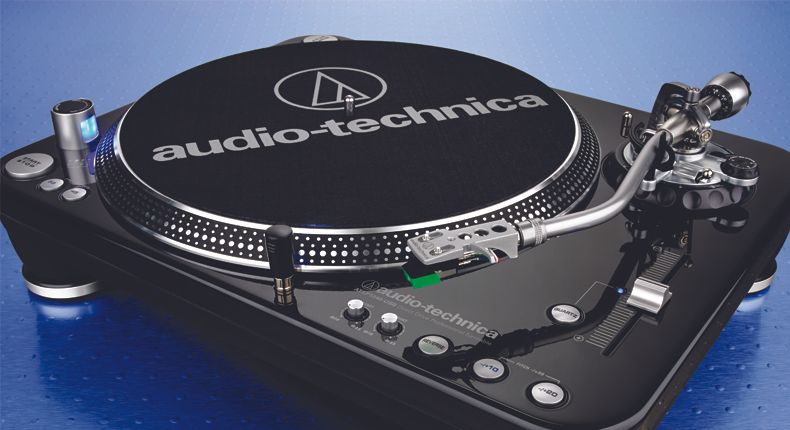The Michell GyroDec, which is now over thirty years old, has become a famous British vinyl classic. It was one of the first ‘skeletal’ designs, with a vestigial sandblasted aluminium chassis rather than a traditional hardwood plinth, when it was introduced in 1981. This, together with the five gold-plated brass weights dangling from the platter (for a gyroscope effect) and the lovely Perspex base and cover, gave the deck a startling aesthetic that was more twenty-first century than twentieth century. Perhaps not surprisingly, given that designer John Michell worked on props for one of the best science fiction films of all time, 2001: A Space Odyssey, which the Gyro is based on.
The turntable has undergone ongoing refinement since its conception, including the addition of a new bearing, an acrylic platter, an off-board motor, a switch from AC synchronous to DC motors, and minor adjustments to the springs and arm plate mountings. But the most significant update to this renowned and gorgeous record player occurred in 2001, when designer John Michell introduced the Spider, which eliminated the regular deck’s huge and resonant Perspex base and lid from the equation and completely transformed the sound.
By removing all of the beautiful Danish acrylic, the asking price was reduced by £200, bringing the deck down to £775 in 2001, just slightly more expensive in financial terms than the original Gyro from twenty years before, but significantly less expensive in real terms. Apart from the plinth removal, no corners were cut. The outstanding inverted bearing is housed in the chassis, which has its own built-in oil pump that runs Mobil One full synthetic oil. The acrylic platter is affixed to this, and gold-plated brass weights are hanged from it to add mass. A high-quality DC motor encased in a huge billet of aluminium drives this through a long rubber belt. This sits directly on the equipment support rather than being mounted to the deck.
Three height-adjustable springs mounted to the base support the chassis. This is a full-size affair with a dustcover and comes in a variety of finishes in the ‘classic’ version of the GyroDec, which is still available. All of this is removed in the Spider Edition, which instead uses a basic glass transparent acrylic ‘spider’ to retain the deck’s feet and suspension mounting points. Finally, all Gyros come with custom-machined aluminium armplates for the tonearm of the user’s choice. These are made to have a constant overall mass of one kilogram when combined with the arm. To compensate, the Gyro chassis contains lead balancing weights on the underside, ensuring that the subchassis is always perfectly balanced regardless of which arm is used. That three-point punishment will be able to execute its work properly in this manner.
Aside from the offboard motor, the Gyro SE introduced two new features. The first was a 40 volt power transformer, which was a significant upgrade over the old 10 volt ‘wall wart.’ This is fortunate, because there was a significant price difference between the normal PSU and the £399 Gyropower QC prior to its release. (For a clean power feed, the latter needed a massive 100VA toroidal transformer and highly regulated quartz synthesized circuitry.) The new spring arrangement, on the other hand, provided significantly better isolation and was much easier to tune. This improvement was also available as a retrofit for roughly £40. Finally, if Spider owners feel they can’t live without a standard base and cover, they may convert it to a classic GyroDec for around £200.
Because all of the Spider’s parts are visible, putting it together is a breeze. It’s as simple as taking each component part out of the package and assembling it Meccano-style. Fit the three spring assemblies to the top of the spider after screwing the three feet to the underside. Then, using the Allen key provided, secure your arm to its mounting plate and bolt it to the chassis. The bearing assembly is screwed in from below, and then the entire chassis is placed over the motor and secured to the base. Then attach the platter to the bearing top, level it with the spring adjusters, connect the motor to its power source, secure the belt, and you’re ready to go!
Simple enough, but there’s still work to be done in order to get it to perform at its optimum. First and foremost, adequate support is required. Second, make sure it’s completely level — you can see how the Gyro’s springs float more freely when it’s perfectly true. Third, the spring adjusters determine not only the chassis height but also the alignment of the chassis with respect to the motor. The latter is crucial, and it should be tuned for the smoothest bounce possible, a procedure that can take up to ten minutes to do properly. Finally, arm lead dressing should be done with caution. Setting up a Gyro is simple, but perfecting it is a bit of a black art — practice makes perfect!
First impressions are really positive, even with a basic arm and cartridge combination. The Gyro SE boasts a sound that is clean, open, and even, with very few flaws. Bass is quick, firm, and long, yet it lacks color and lumpiness. With Cinemascopic stereo image, massive quantities of low-level information, neutral tone, and powerful, if not outstanding, dynamics, the midband is a pleasure. With bell-like harmonics and superb extension, the treble is crystal clear. It’s a capable performer by any standard, let alone those of competing turntables.
The GyroDec SE always sounds lovely, open, and stretched, whether it’s a vintage Karajan recording of Beethoven’s Fifth Symphony or LTJ Bukem’s thundering “drum n’ bass”. In absolute terms, it’s a tad warm, but it’s neutral enough to highlight the contrasts between, example, a Stax album from the 1970s and one made at The Power House in the 1980s. It’s also slightly pitch-unstable; you’d never know until you listened to the best high-end decks, like its bigger brother the Orbe, which sounds gutsier and more confident. The Gyro is rock-solid by Rega standards, but spend twice as much and you’ll get a more secure soundstage and better confidence with piano music, for example.
The GyroDec SE has a performance that is extremely close to true high-end vinyl esoterica at a price that is closer to a Rega P3-24. That makes it fantastic value, and it’s not only because of the incredible sound — Michell decks are extremely well-built and finished, as well as being works of art in their own right.






